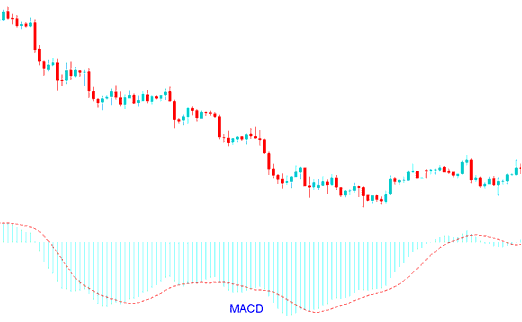No Nonsense Indices MACD Analysis
The MACD indicator was developed by Gerald Appel.
MACD Indicator is one of the simplest and most commonly used technical indicators available. MACD Indicator is a momentum oscillator with some trend following characteristics. The most popular technical analysis of MACD Indicator first calculates the difference between two moving averages and plots that as the MACD Indicator 'Fast' line: A second MACD Indicator 'Signal' (trigger) line - Trading Signal is then calculated from the resulting 'Fast' line & plotted in the same frame as the MACD Indicator 'Fast' line. The 'standard' MACD values for the 'Fast' line are a 12-period exponential moving average and a 26-period exponential moving average and a 9-period exponential moving average for the MACD Indicator 'Signal' line.
Explanation of MACD Indicator - No Nonsense Indices MACD Analysis
MACD Indicator is widely used as a trend following indicator and tends to work most effectively when measuring wide swinging stock market price movements. There are three basic techniques for using the MACD Indicator to generate signals.
MACD Crossover Signals:
1. MACD Indicator Fast line MACD Indicator Signal line Crossover: A buy signal forms when the MACD Fast line crosses above the MACD Signal line and a sell signal forms when the MACD Fast line crosses below the MACD Signal line.
2. Fast line / Zero-Level Crossover: - No Nonsense Indices MACD Buy & Sell Signal Indicator When the MACD Fast line crosses above zero center line mark a buy signal is given. Alternatively, when the MACD Fast line crosses below zero center line mark a sell signal is given.
MACD Divergence Signal:
divergences between the MACD indicator and price can prove to be a very effective indices strategy in spotting potential trend reversal and/or trend continuation points in price movement. There are several types of MACD indicator divergences:
MACD Classic Divergence
- MACD Bullish Divergence = Lower lows in price & higher lows in MACD indicator
- MACD Bearish Divergence = Higher highs in price & lower highs in MACD technical indicator
MACD Hidden Divergence
- MACD Bullish Divergence = Lower lows in MACD and higher lows in price
- MACD Bearish Divergence = Higher highs in MACD and lower highs in price
MACD indicator Overbought Oversold Levels:
The MACD indicator can be used to identify potential overbought and oversold levels in price movements. These MACD indicator overbought oversold levels are generated by comparing the distance between the shorter moving average & the longer moving average: if the shorter moving average separates dramatically from the longer moving average it might be a signal that price is over extending & the price will soon return to more realistic levels.
Implementation of MACD Technical Indicator
The MACD indicator Fast Line is drawn as a solid blue-line. The MACD indicator Signal Line is plotted as a solid redline. A green histogram plot that represents the difference between the MACD Fast-line & the MACD Signal-line has also been included to make identifying MACD indicator cross over points easier.

No Nonsense Indices MACD Analysis - No Nonsense MACD Strategy


